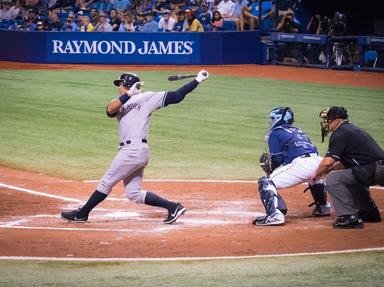Quiz Answer Key and Fun Facts
1. The New York Yankees' Jason Giambi had a batting average of just .253 in 2006, but was able to reach base over 41 percent of the time, or more often than all but five players in the American League. The difference between his batting average and on-base percentage or OBP is best explained by his number of these.
2. Pittsburgh's Freddy Sanchez won the 2006 National League batting title, but his .841 OPS was a whopping 261 points below league leader Albert Pujols of St. Louis. OPS is a combination of a player's on-base percentage and which other statistic?
3. The 2006 American League leader in OPS was which Cleveland Indians designated hitter who posted an OPS above 1.000 for the second straight year?
4. Many people trace the recent surge in popularity of "sabermetrics" statistics to Michael Lewis' book "Moneyball". It chronicled the highly successful implementation of this approach by this perennially low budget franchise and its general manager Billy Beane. Which team was it about?
5. This oddly-named statistic measured how many Hits and Walks a pitcher gives up on average for every inning pitched.
6. Sabermetricians have developed pitching statistics like Fielding Independent Pitching (FIP) as an alternative to the traditional Earned Run Average (ERA) to better account for which of the following?
7. Traditional measures of fielding rely on potentially subjective factors such as errors, which may not account for how many plays a player should have made relative to the average player at his position. As a result, sabermetrics experts often disagree with recipients of which award for the top defensive player at each position?
8. Stolen bases are another favorite sabermetrics topic, with efficiency (in terms of not being caught) being considered at least as important as the number of stolen bases. The authors of the book, "Baseball Between the Numbers", argue that notoriously slow-footed Pete Incaviglia's career base running record actually compared favorably with which speedy player, who exceeded Lou Brock's previous record by over 400 stolen bases?
9. A central concept for evaluating a player's contribution to a team is how many wins (as calculated by various complex formulas) a player contributes compared to the average "replacement player", using statistics like VORP or Value Over Replacement Player. A replacement player generally refers to what?
10. Not everyone buys into the validity or usefulness of these new statistics. This former Cincinnati Red and Hall of Fame second baseman famously uttered, "Anytime you're trying to make statistics to tell you who's gonna win the game, that's a bunch of geeks trying to play video games." Who said this?
Source: Author
beanster
This quiz was reviewed by FunTrivia editor
Nightmare before going online.
Any errors found in FunTrivia content are routinely corrected through our feedback system.
